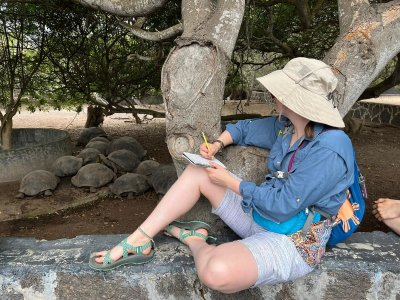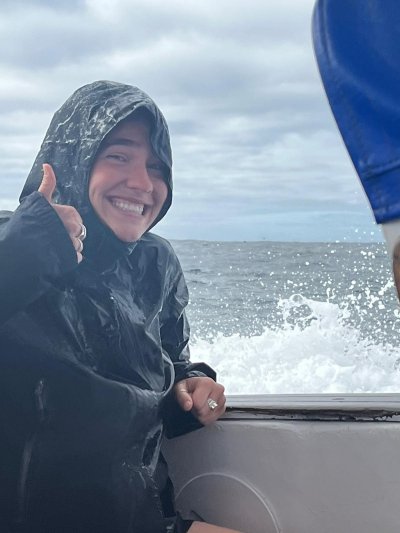Postcards from Ecuador: Giant tortoises and quiet beauty in the Galápagos
The group’s first day on the Galápagos was a busy one.
After a tour of a pair of pit craters - sites where a now-empty lava dome has collapsed into what looks like a massive sink hole - the group stopped for a face-to-face encounter with one of the islands’ most iconic residents: the Galápagos tortoise.
Stopping for lunch at a local tortoise sanctuary, the students and staff got to sit down just six feet away from the gentle giants while the guides informed them of what challenges the slow-moving leviathans had faced and still face today.
“Over the centuries, these magnificent animals have been hunted almost to extinction in some of their island ranges,” said the group’s guide, Vicki Flores. “Even now, with conservation efforts in place, their population is only 10-12% what it once was.”
As the group sat and watched the tortoises quietly graze on grasses, it learned that the biggest males can reach a size of more than 900 pounds and live as long as 150 years or more. There are four breeding centers in the islands to assist with repopulation efforts.
Next stop would be our hotel for the night in the quiet, friendly seaside town of Santa Cruz Island's Puerto Ayora, the most populated area in the Galápagos.
After the hustle and bustle of big cities like Quito, Cuenca and Guayaquil, the extremely laid back island culture of Puerto Ayora seemed like a tonic to students, who explored the town, went for swims, and generally took a group exhale.
“This place is incredible. I wish I could live here, seriously,” said student Jessica Dietzman, and it was a thought shared both aloud and unspoken by many in the group.
But, explained our guide, to Ecuador’s credit, Jessica’s daydream could not presently become a reality. The only people who can live in the Galápagos are its native inhabitants; everyone else, mainlanders and foreign visitors alike, get two months maximum before they have to leave.
Were these restrictions not in place, places like Santa Cruz would quickly lose their local culture as tourism and development would work to turn one of the world’s jewels into simply another island with beautiful beaches.
“Thankfully this is not so,” said Flores. “And these islands will remain undeveloped and hopefully as pristine as they are now.”
The group turned in early, as it would be another early start the next morning, this time for a much anticipated ferry. Arriving at the ferry dock at 6 a.m., the group took water taxis out to the high-speed ferry that would take them to the final “new destination” of the trip: Isabela Island.
The trip was two hours across the open Pacific, with the ferry shouldering aside the broad ocean swells to finally (and somewhat providentially for a few green-around-the-gills group members) arrive at Isabela’s main population center, Puerto Villamil.
“That was so amazing,” said student Jenavieve Barson after once again setting foot on terra firma.
After being greeted by a gaggle of snoozing marine iguanas, the group cleared customs and prepared for another full day of activities at its final island home of the trip.
TOMORROW: Pink flamingos, playful sea lions, and swimming with sharks.

